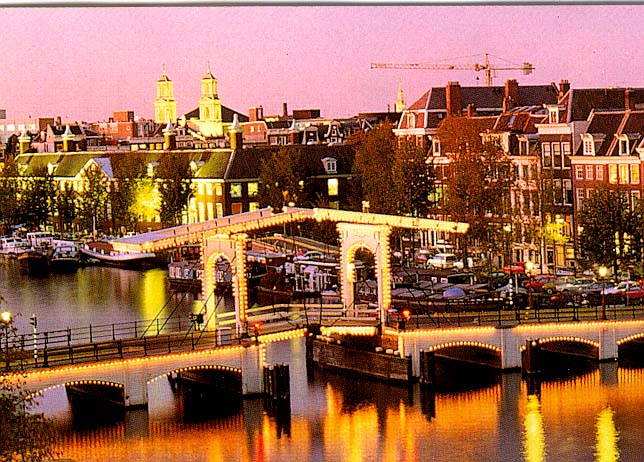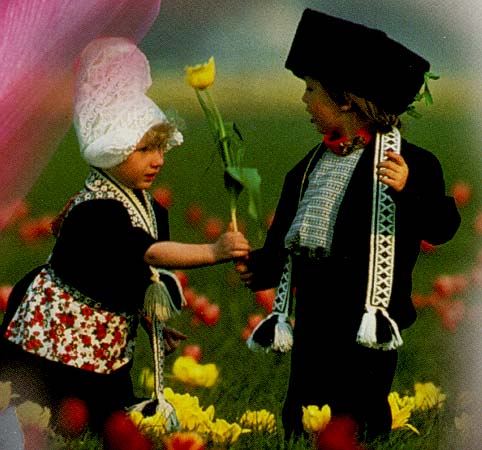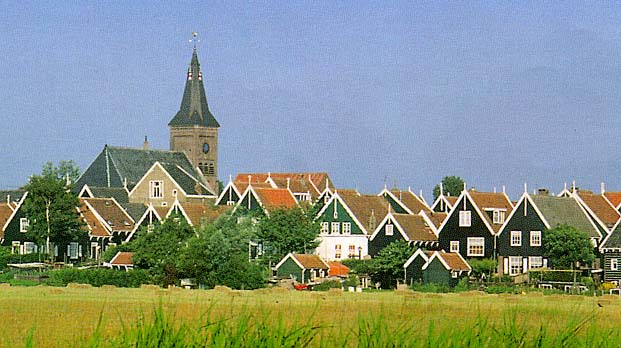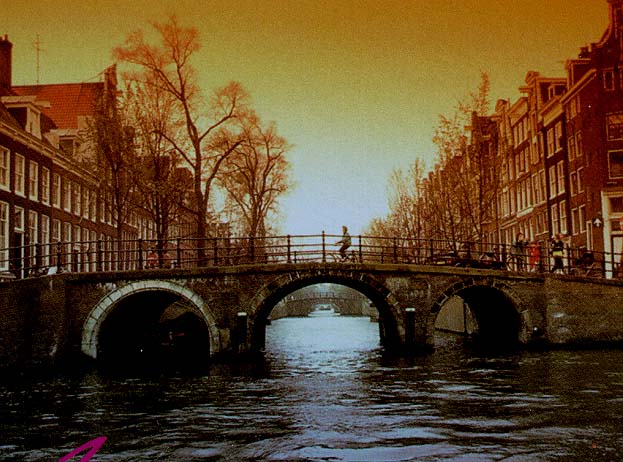Population
Organization
Environment
Technology
Population has been exploding for the last fifty years. After World War II, the Netherlands had a baby boom that outlasted all other countries. The result has allowed the country to consist of many forty-ish aged people, and a growing amount of young people. The life expectancy is much like the United States; with men living an average of seventy-five years and women eighty-one years. This accounts for many people of all ages inhabiting the land. Because of the denseness of the area, the government has actually encouraged emigration to keep population down. After a first request in the 1950ís, around 500,000 Dutch left the country. Incredibly, the high number of immigrations to the country outnumbers those leaving, and the population in the Netherlands cannot stand still. It is growing day by day, and the lack of land does not deter people from moving into the prosperous country.
Due to the high numbers of people traveling in and out of the country, demographics in the Netherlands is varied. The countryís people consist mostly of Dutch, but there are many different minorities that have relocated there. The majority of the public is from Europe, Asia, Indonesia, and other Mediterranean countries that have permanently moved to the Netherlands, thanks to the close proximity. The Netherlands is a popular and liberal place to live, and many people are constantly moving into the cities.
In cities, there is a large demand for housing. Due to the many
dikes and waterways, there is limited land to build on. They have
begun making houses very narrow, giving no limit on the height. Therefor,
when looking at a block of the city, the houses are connected to each other,
only yards in width, yet standing three stories tall. For people
in the rural areas, many homes are spread out from each other. Many
also have moats infront of their house, or around, due to the dikes.
Yet they serve almost as a safety precaution. If the homeowners
do not expect guests and are in for the night, they can easily haul in
the bridge that connects their homeland to the rest of the land.
This sort of creates their own island, in the middle of the country.
Social structure of those living together differs. As in all cases there are exceptions, but the sandwich generation recognizes their responsibility to both generations around them. They are taking care of both their children, as well as their parents. Yet it seen that children in this era are waiting longer to get married, and more are living with friends or alone before marriage. This is opposite with the elderly, it is not uncommon for parents to move in with their children in later years. This causes large families to be housed in one location.
The political system in the Netherlands consists of a constitutional monarchy with a parliamentary system of government. It is governed by their constitution, written more than one hundred and fifty years ago. The second part of the political system is the legislative branch that is their parliament, which are the designated rules that regulate the procedures that the country is run by. The third part of the political system is the judiciary branch. There are courts in all parts of the Netherlands, there to solve disputes and conflict.
These three branches of the government help direct the local government, which is closer to the people. There are twelve provinces in the Netherlands, all that have their own division of local government. The provinces consist of Drenthe, Flevoland, Friesland, Gelderland, Groningen, Limburg, North Brabant, North Holland, Overijssel, South Holland, Utrecht, and Zeeland. The monarch appoints a commissioner to rule over each individual province. The provinces are further divided into more than seven hundred municipalities, total in the country. Their own council and mayor, who takes orders from the commissioner, govern each municipality. These lowest levels of government have limited power, and its basic service is to keep the peace in their distinct area.
The economy in the Netherlands has long been centralized in trade, yet other large industries include for the Dutch have been shipping, fishing, trade, and banking. The government is careful to regulate all industries, the people running them, as well as income. To eliminate circumstances that spur on a social class system, the Dutch have limited the wealth of the people in the nation. There is no real distinction between the rich and the poor, because the wage is stuck around $17,940 a year, per person. The government does not allow a class system to develop.
The Netherlands has worked hard to establish a housing market and regulate society. The urban society is in great condition, with no extreme forms of polarization and poverty. The Dutch claim that there society is in such good shape because the of regulation. They have rest control and subsidies for the production of housing and for consumers, which allows people to be able to buy. They also have houses that are non-profit, in the social rented sector of the housing stock. This allows people who are in below level income brackets to still have housing.
The Dutch dress much like those in the United States. They are seen in the average dress of those we in America see daily. The norm is jeans, T-shirts, shorts, etc. Traditional costumes of Holland are not existent in the daily life of the Dutch. The traditional apparel was simple and efficient to working people. Men wore trousers, and plain shirts with sleeves. The women would wear long skirts, with blouses and lace caps. The fabric was made from hemp in the earlier days, when it was legal. Apparel was made durable and resilient to the cool and damp weather. It was common to see shirts, skirts, and pants with billowy sleeves, and an excess of material. Overall, the traditional costumes for the Dutch were rather plain and modest looking.
Religion is another difference among people that comes with having a variety of cultures. The majority of the population is classified into being Roman Catholic and Protestants. These two religions take up about 65% of the population. There is a small minority of people following the Jewish faith. The remaining percent of people, about 25-30%, do not state their religious orientation. The Netherlands does not have a definite or official religion.
The Dutch eat an array of foods, many of them being from the sea.
A large part of their diet is herring, smoked ell, and oysters. It
is not uncommon to see local fisherman selling their goods on street carts.
Another portion of the diet consists of heavy and rich soups, usually very
thick and creamy.
The natural landscape of the Netherlands has been altered in various ways in the last centuries. Due to the water overtaking the land, extensive vegetation is not possible. The arable land is around 26% of the entire land. They are able to grow the necessities, agriculture that thrives in somewhat moist soil. Large animals are few, but small animals do live in the moshlands, such as rabbits. The expansive amount of water has definitely had an effect on all regions of the country.
There are three distinct land regions in the Netherlands. The parts consist of the coast, the polders, and uplands. The first is the coast, which is low, narrow and sandy. There are man made dikes in the western parts of the land. The Dutch had to build them when the North Sea started to overtake the land. They built these dikes to drain water from the land in half moon loops that are miles long, and miles into the land. The canals of dikes are simply made from earth, following its own natural flow. The second region is the polders. Polders are areas of land that were once covered in water. The Dutch had to weave dikes inland to drain these parts of land to live on. This region is in the west of the country, with most of it below sea level. The last region is the uplands, which is in the east of the country. This region has low elevation, with slight rolling hills, and no need for dikes. The land is barely past 50 meters in the highest parts. Forests and moshlands cover about 7% of the land.
If the sea were not the only inconvenience for the Dutch, they have three rivers that open up over nearly half of the country from the inland parts of Belgium and Germany. Deltas are prevalent all along the shores of the Netherlands. They have even been forced to build many dams to control the flow of water from the Rhine, Maas, and Scheldt. The Rhine is the largest river, flowing from Germany, and creates smaller rivers from the mouth that run across the Netherlands. The Maas and the Schelde, both flow from Belguim, creating more small islands and waterways. If they were to allow the rivers to take their course, the country would have long ago been underwater. Water is a large consideration in Holland. Direction the water flows in dikes and rivers must be monitored, to keep the country from falling below sea level.
The majority of the Netherlands consists of water. This is both an inconvenience, as well as a positive aspect. It is an inconvenience in the respect that the Dutch are in constant survey of the land, to make sure that it does not fall below sea level. They must remain be able to control the waterways, or the entire country will become apart of the North Sea. Yet it is definitely a bonus for the Netherlands because they are at the base of three major rivers, and across the sea from Great Britain and Sweden. This allows people from inland Europe to reach them easily on the rivers and others to travel across the sea to them. This puts the Netherlands in the center of a huge hub of trading centers, perfect for helping the country prosper. Spain, France, Germany, Switzerland, Czech, Sweden, Indonesia, and the list goes on of all major countries that have easy access to the Netherlands. If it were not for the Netherlands being so easily reachable by so many countries, it would not be so successful.
The land of the Netherlands is not flush with trees; so wood products
are at a minimum. It is most common to see houses made from cement
and stone. The country has a large industry for cement to assist
in the sort of goods that are needed to replace trees. The streets
are also made from cobblestones in the cities. This is mostly because
of the majority of walkers, and the small walkways. Overall, the
country is much more prone to use stone and cement to build up their infrastructure
than any other materials.
TECHNOLOGY
The Netherlands is a country that has undergone prosperous growth, and
on the way has accumulated more than its share of technological, creative,
and scientific advances.
Netherlands was slowly going under water when they began the necessary building of water canals. They made dikes to begin lessening the pressure of the water on the land. Then they made the first windmill, or power-driven engine pump came into use. Windmills have been a trademark for Holland for quite some time. They are now hundreds spread over the country to pump water from small dikes into large dikes that will assist the water to draining into the sea.
After saving the shoreline from being sucked into the ocean, the Dutch decided to increase their land by draining inland bays. The first polder they drained was 50,000 acres, now the northwestern city Wieringermeer. They even thought to drain a bay near the shoreline to add 950 miles to the country. This is a lot of land for such a small country, but the result has given the Netherlands not only more land, but moist soil rich in nutrients.
The Netherlands is famously known for the array of artists that have come from there. In the 1600ís, Dutch baroque artist, Rembrandt, made an unforgettable name for himself. He is probably one of the greatest painters in the history of Western art, drawing and etching with a profound understanding of human nature. Another world known artist is the Dutch postimpressionist painter, Vincent Van Gogh. His work represents the archetype of expressionism, the idea of emotional capriciousness in painting. Both of these artists and many more that traveled to the Netherlands to paint and draw- helped the Dutch into an elevated status.
The Netherlands has also enjoyed the fame from several scientists, who
made incredible breakthroughs in the field. Christiaan Huygens, in
the 1600ís, made his name as an astronomer, mathematician, and physicist.
His discoveries included the principle that every point on the front of
an advancing wave is itself a source of new waves. From this principle
he developed the wave theory of light. He was also the first astrologer
to give an accurate description of Saturn. There is also the scientist
Antoni van Leeuwenhoek, who made one of the first microscopes. With
that he also discovered the life cycles of insects, and how red blood cell
flowed. These are just two of the scientist who made advances in
the Netherlands.
Home
Top of page
This page was created by Lisa Danduran as part of the requirements for FCS428 International Housing in the Spring of 1998 at California State University, Long Beach.
![]() ©1998
- This series of pages was developed in electronic form and made available
on-line by: Dr.
Lydia Sondhi, Family and Consumer Sciences, California State University,
Long Beach.
©1998
- This series of pages was developed in electronic form and made available
on-line by: Dr.
Lydia Sondhi, Family and Consumer Sciences, California State University,
Long Beach.
last updated: 05/12/98



